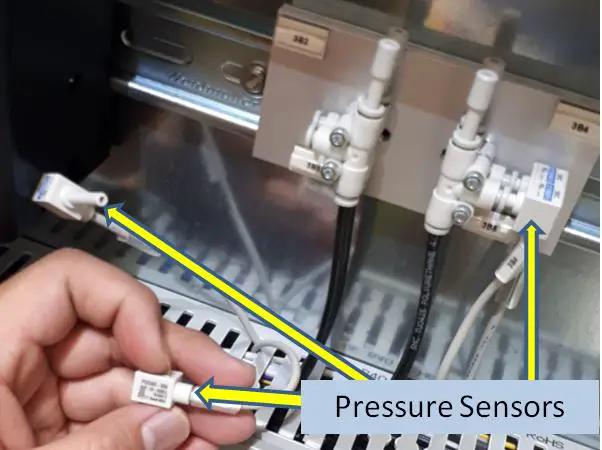
Are you familiar with this type of pressure sensor?
I cannot remember when is the last time where I calibrated this type of pressure instrument that is why I am excited to present it with you.
I was amazed the first time I saw it because it is so small but has the capability to sense and measure pressure.
We also have a hard time locating it because of its small size and the way it is being installed, but luckily, we found it deep inside the testing machine.
I rarely see this type of pressure sensor and maybe it is a good thing to share it with you in case you are not familiar with it.
I will share in this post the setup and procedure on how we perform the calibration including a simple verification using the manufacturer specs as a tolerance.
Visit my other post to learn more about calibration and verification.
What is a pressure sensor?
A pressure sensor which is also known as pressure transducer is a device that is powered electronically where it senses pressure to be converted to an electrical signal.
This conversion to an electrical signal allows it to be used and monitored by programmable controllers and other similar electronic devices.
A pressure sensor of this type ( Make – Model: SMC – PSE 548-R04) is used in a special way. It is a leak tester installed in a machine that is used to test a car battery housing. It detects the leak through a pressure variation over time.
This is a pneumatic pressure sensor, it means that it is using air as the fluid. And therefore, during calibration, we will also use a pneumatic pump to generate pressure.
How to calibrate a pressure sensor?
Most pressure sensors or transducers can be calibrated by taking its electrical signal as the output, usually, a voltage or a current then calculates its equivalent pressure values.
But
Read more below for the calibration setup and procedure
What to use to calibrate pressure sensors?
In this setup, we will be using a Fluke 754 with a Fluke 700P05 pressure module as the reference standard.
We will use a pneumatic hand pump with a pressure module connected to a process calibrator to simulate pressure.
Pressure Sensor Calibration Setup
Pressure sensor calibration setup- showing the input ports for supplying pressure
1. This is an SMC PSE 548-R04 type pressure sensor, so the input port is using only a quick connect tube.
2. Connect in the port as shown above the output of the pneumatic pump.
3. If you have the exact connector, just directly plug it in the port. You are now ready to supply the necessary pressure.
Pressure Sensor Calibration procedure.
1. Once it is properly set up and has stabilized, pump the necessary pressure.
2. Supply an increasing pressure. S
3. Then apply
4. Record in your Measurement Data Sheet. Perform 2 trials
How to P
We will be using the manufacturer specs as a basis for tolerance to determine a pass or fail results.
- The pressure sensor has an accuracy of 2% of FS
- Fulls Scale reading is = 1 Mpa
tolerance limit = 0.02 x 1 = +/- .02 Mpa
- Therefore, reading should be within +/- 0.02 Mpa
Conclusion
I have presented here, for me, is a rarely seen pressure sensor where I believe others also are not familiar with it. I also discussed a simple calibration and verification procedure using a pneumatic pump with a pressure module.
Thank you for visiting my site.
Please comment and subscribe.
You can also connect with me on my Facebook page.
Best Regards,
Edwin
6 Responses
Kristian
thanks for this information. But we don’t have a pressure sensor yet, only the pressure gauge. Do they follow same procedure?
edsponce
Hi Kristian,
You are welcome. Appreciate that you like my post.
Yes, a pressure sensor follows the same procedure with the pressure gauge. The difference would be the range of the pressure module to be used, just in case you have a higher range pressure gauge, plus some positioning during calibration.
I have written a separate post about pressure gauge calibration, Please visit this link.>> pressure gauge calibration
Hope this helps
Thanks and regards,|
Edwin
Jairahlyn
How about the pressure transducers? how can we calibrate it using affordable test equipment? What is an alternative standard for the Fluke 754 with a Fluke 700P05 pressure module? Just for our school thesis. Hoping for your immediate response. Thank you 🙂
edsponce
Hi Jairahlyn,
You can use a digital test gauge or a digital pressure gauge (see sample in this link >> digital pressure gauge) with an accuracy of 0.25% and below for better performance. You still need a pneumatic pump as the pressure source (or any gas pressure source that you can control accurately) and a separate digital multimeter to measure the current value at 4 to 20 mA.
I hope this helps,
Edwin
Michelle
Hi Edwin, We have checked our pressure sensor with a fluke pressure gauge and documented the results. If the pressure is set at 500psig and the reading is 523.1 on the gauge, does that meet the tolerance? If not, why?
edsponce
Hi Michelle,
Do you already know your tolerance limit? You need to determine first your tolerance limit before we can perform a verification.
Let say for example that your tolerance limit is +/- 25 psig, this means that your reading is still acceptable, the acceptable range is from 475 to 525 psig, but if you exceeded this limit then it is a fail.
If you do not know your tolerance limit, you can start with the manufacturer specifications. Check the accuracy part in its manual.
To learn more on other rules in determining if results have passed or fail, check out my other post here >> decision rule.
I hope I answered your question.
Edwin